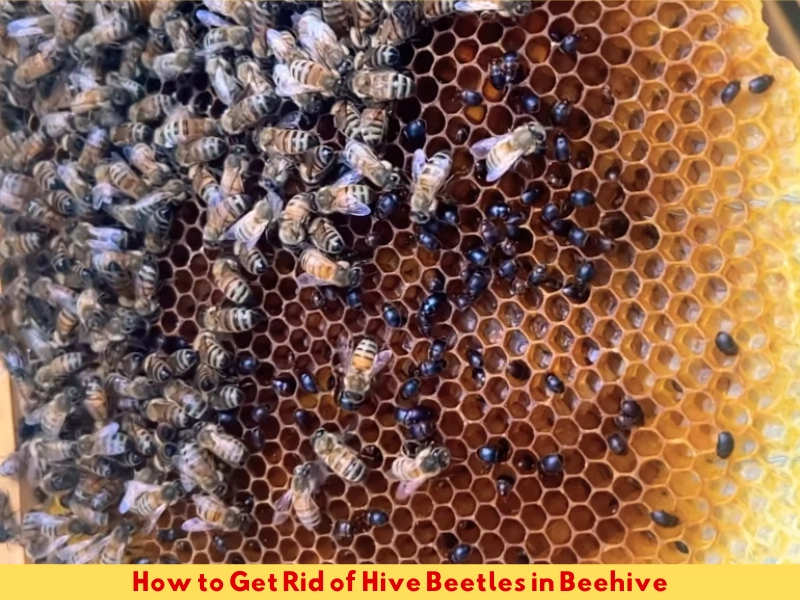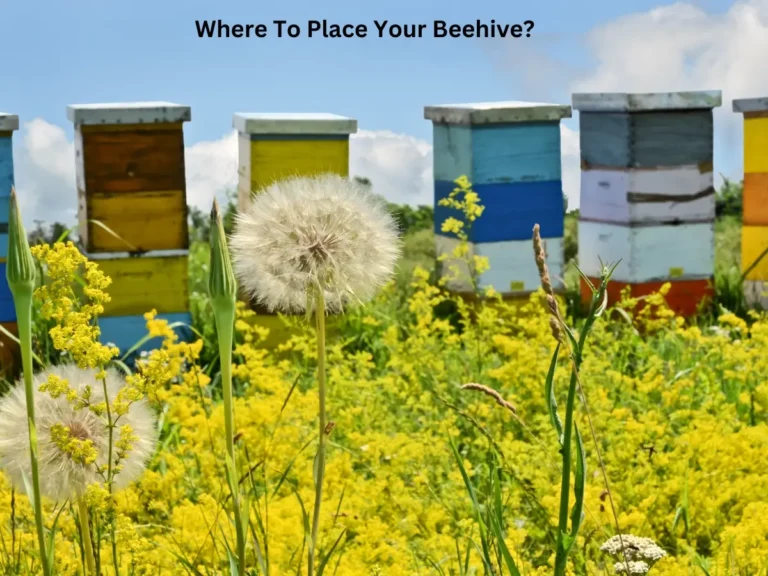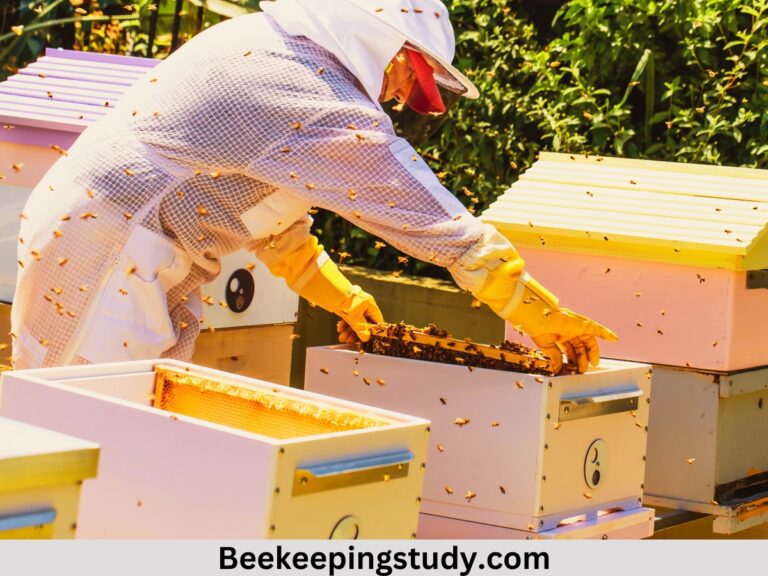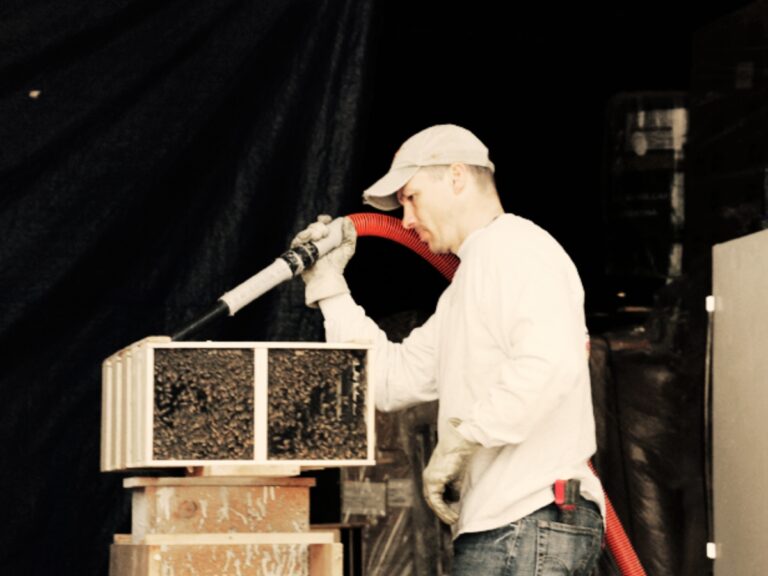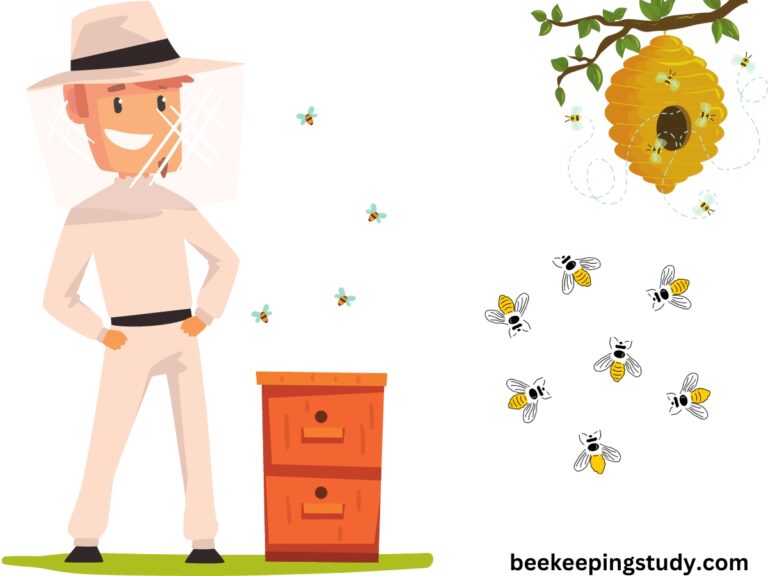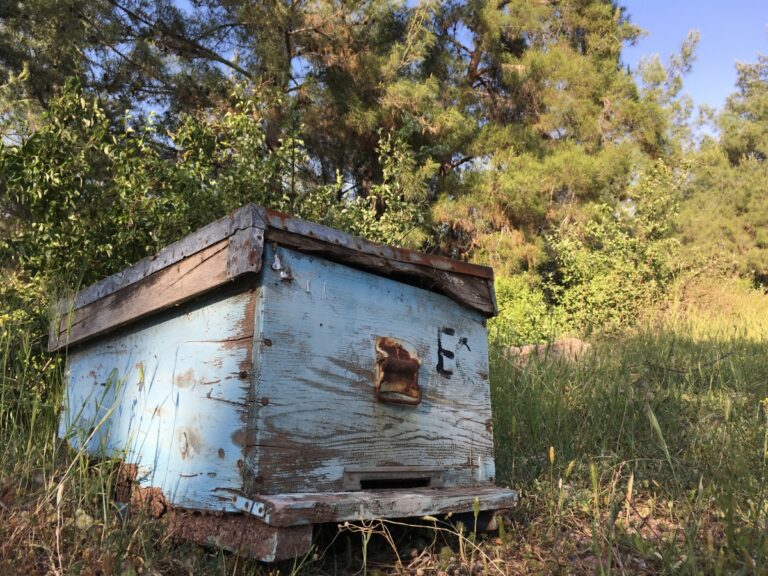This post might be created with help from AI tools and carefully reviewed by a human (Anthor Kumar Das). For more on how we use AI on this site, check out our Editorial Policy.
How to Get Rid of Hive Beetles in a Beehive
Hive beetles are a common problem for honey bee colonies. If you are a beekeeper, you must know how to get rid of hive beetles in a beehive. That’s what I am going to teach you in this beekeeping guide.
This article is going to be a bit long because I am going to discuss with you a lot of things about dealing with hive beetles in beehives. So, you can go through the table of contents section to navigate to any specific section of content.
Last year, I had a huge number of beetle problems in some of my beehives. Initially, I thought bees would be enough to take care of them. But unfortunately, within a few days, the beetle problem goes beyond the control of the bees.
So, I started discovering a large number of dead bees around the beehive. Thus, I decided to do something. Fortunately, taking the right decision before it’s too late, I successfully helped my bees to overcome the hive beetle problem and prevent slime out.
That’s what I am going to discuss with you in this tutorial. Not only just how to get rid of hive beetles in beehives, I am going to discuss quite a lot of things related to this concern.
Generally hive beetles if limited in number and the colony is strong bees will take care of them. You don’t have to be do anything. But if the colony is weak or the beetles are large in numbers the colony are in big big trouble. The colony will be slime out and if left unchecked for long, the entire colony might die out or swarm away.
What are Hive Beetles?
Hive beetles, more specifically small hive beetles or “SHB”, are very opportunistic and a real problem for honey bee colonies. It’s a small, dark insect about 5 to 7 mm long, with shiny wings, clubbed antennae, and a flattened body.
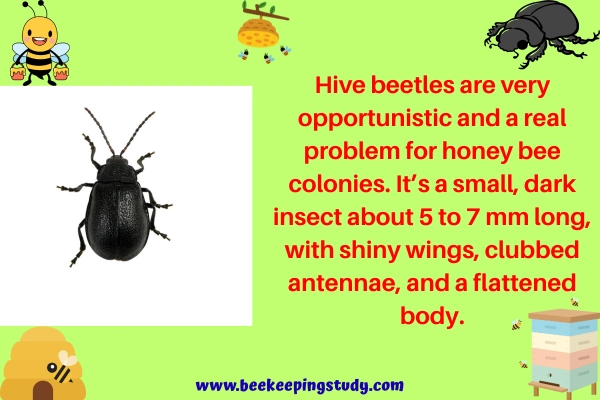
Hive beetles originated in Africa, mostly in the sub-Saharan desert area. However, it has expanded its presence to North America, Australia, the Philippines, and some parts of South Asia.
When these beetles got inside a beehive, they started laying and hatching eggs in cells, honeycomb, and any part of the frames. They can lay 20-40 eggs in a single cell. When the eggs hatched, larvae came out and they started to spread all over the frames, honeycombs, and other parts of the beehive.
The larvae feed on the honeycomb, pollen, and brood, turning everything into a fermented, slimy mess. This is why hive beetles can become a serious trouble for the honey bee colony if left unchecked for long.
Small Hive Beetles can reproduce and spread very quickly. Thus, proper action has to be taken if you see bees struggling to deal with SHB problems.
How to Identify Small Hive Beetles in a Beehive?
The easiest way to identify small hive beetles is just pull over the top cover of your beehive. When you pull the top cover, you might see small brown or black insects rolling over and trying to hide super fast within the frames. Those tiny black culprits are hive beetles.
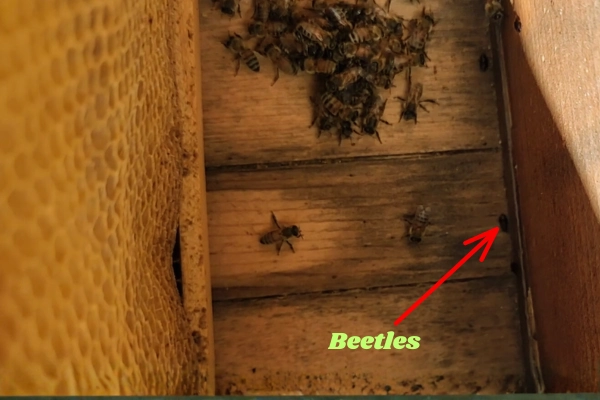
Make sure you are approaching the hive inspection only when the timing is correct. Don’t inspect the beehive during a situation that can negatively impact bees.
However, it’s not guaranteed that this single method can ensure the presence of hive beetles in the beehive. Here is a complete checklist to identify small hive beetles in a beehive.
1) Look for Adult Beetles Moving Quickly
- Adult small hive beetles are about 5–7 mm long, dark brown to black, and somewhat flat.
- You’ll often see them scurrying quickly across the top bars or between frames.
- They avoid light, so when you open the hive they may dash under frames or to dark corners.
2) Inspect Hive Corners & Crevices
- Check under frames, in corners, and in cracks in the wooden hive parts.
- Beetles like to hide in small gaps out of the bees’ reach.
- Sweep your brush gently over frames to spot beetles that scurry out.
3) Look for Larvae & Escape Tunnels
- Larvae are creamy white, worm-like creatures, maybe 4–6 mm long.
- You’ll find them crawling over combs or in debris at the bottom board.
- Also look for small tunnels or holes where larvae might have moved.
4) Spot Slimed or Fermented Honey
- When larvae feed, they excrete digestive juices that turn honey, pollen, and brood into a slimy, fermenting mess.
- You may see honey dripping or liquid pooling.
- Frames may look “mushy,” or brood cups may leak.
5) Turn Off Light & Listen at Night (Optional Trick)
- Close up your hive late and listen.
- Sometimes on still, hot nights, beetles move, and you may hear soft scratching noises in empty hive areas.
- Use a red light or dim torch if you need to peek in, so you don’t disturb the bees too much.
Following these methods, you will surely discover hive beetles if they are actually present in your hive.
How to Get Rid of Hive Beetles in a Beehive
So, if you find small hive beetles in any of your beehives, you might become worried. But you don’t always have to do something to help bees dealing with SHB.
First, let’s learn when to take action against hive beetles and when it is not a matter of worry. Then I will discuss with you different methods to get rid of small hive beetles in a beehive.
When to Take Action Against Hive Beetles?
Hive beetles in a beehive are normal during warm seasons, and if the colony is strong enough. A strong colony regularly cleans debris, moths, mites, and beetles.
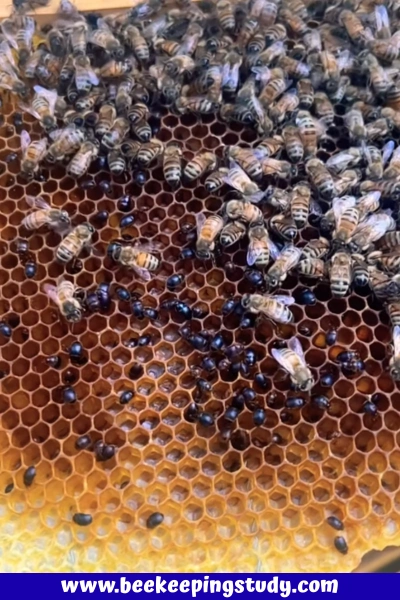
So, if your colony is strong enough, bees will take care of the small hive beetles on their own. In such a case, you don’t have to do anything for the next few days.
So, when you first discover a small number of hive beetles inside a strong honey bee colony, leave them for at least 3 days. If you see hive beetles number decreasing fast within these 3 days, then relax! Bees are handling these beetles.
But if you see the hive beetles are increasing and large in number even after 3-5 days. Then you must do something to protect the colony from slime out.
There is another secret hack to be sure that the colony is going to slime out. Thus, you have to take immediate action.
Monitor Soil Near Hive
After larvae exit the hive, they pupate in the soil near the hive stands. Dig 5 to 10 cm deep in the soil under and around your hive stand and look for small brown pupal “cocoons.”. If you find many, that’s a strong indicator of beetle pressure.
Under such a situation, you have to take immediate action against small hive beetles to save the bees.
Ways to Get Rid of Small Hive Beetles
When you see an increasing number of hive beetles, you have to stop them to protect the honey bee colony. Last year, when dead bees were discovered all over the ground around my beehive, I found a large number of small hive beetles infestation inside the beehive.
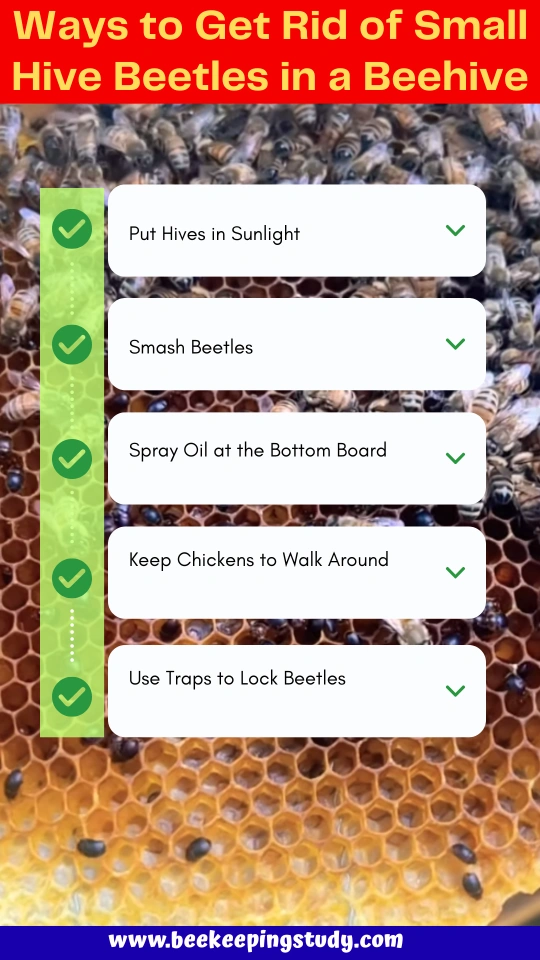
I started researching about “how to get rid of small hive beetles in a beehive”. I found several useful resources and applied the lesson.
Within a few days, I successfully removed all the hive beetles from my beehive. Doing so, thankfully, I protected my bees.
Thanks to Mr David Burns, whose tutorial really helped me to deal with the hive beetle problem in my beehive.
Here are the methods that I followed and find useful to get rid of hive beetles in a beehive. Try multiple of these methods together for the best result.
1) Keep Your Beehive in Direct Sunlight as Much as Possible
Beetles likes cool and humid areas. They can’t tolerate hot and warm areas for long. This is why keeping the beehive in an area having direct sunlight for most of the day will be very effective.
I know it is not always possible. But try to place your beehive in such a spot, at least for the period of treating beetles.
In most cases, this single step can effectively help you to get rid of small hive beetle problem.
2) Smash As Much Beetles as You Can
It is a kinda warning, but the most effective method to get rid of hive beetles fast. Open your hive and look through the boards and frames, try to smash as many beetles as you can.
For this work 2 most common hive tools will be handy for you.
- J-Hook
- Traditional Hive Tool
J-hook will help you in lifting the frames. Look closely for black beetles rushing around and use the traditional hive tool to squeeze or smash them. Traditional hive tool have a bend on the end, making the smashing of hive beetles easier for you.
You can also smash those tiny beetles with your thumb or finger by squeezing them. That’s what I do without any hesitation.
But be careful, instead of smashing the beetles, accidentally don’t smash bees or bee larvae. So, while trying this method, always try to be extra careful.
If you are unsure, don’t go for it. Kill only the beetles that are in the bottom tray or bottom boards and other parts of the beehive where no bees are present.
3) Spray Oil in The Bottom Board
This is another effective method to get rid of small hive beetles in beehives. You can use any kind of oil, such as vegetable oil, palm oil, or any kind of essential oil.
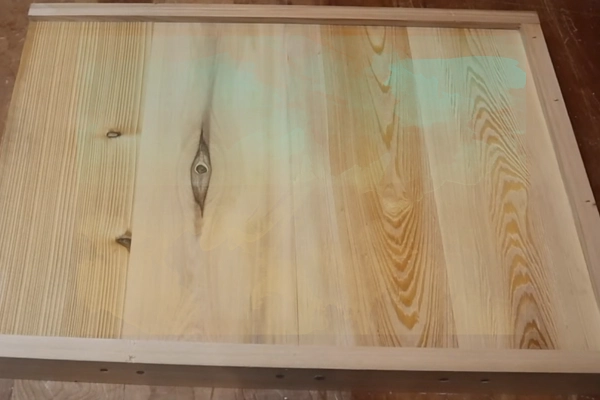
Just spray the oil over the bottom board and put the bottom board in its place. Keep the hive as it is for a few hours.
When bees clean the hive, beetles will drop down to the bottom board and will get stuck on the oil. Also, the larvae after the eggs hatch will try to come out from the hives and will be locked on the oil in the bottom board.
Then you can take the bottom board every few hours and smash those beetles or clean it. If you find the oils are gone, you can spray oil on the bottom board again when necessary.
4) Chickens Can Be Handy to Deal with Beetles
Chickens love to eat small insects like hive beetles. Let your chickens riding around your beehives several times a day. They will eat up all the pupae of beetles in the ground around your beehives.
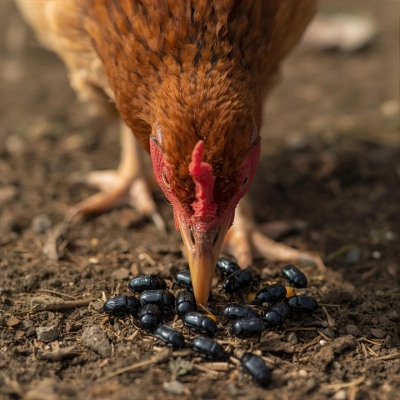
You can also give the bottom boards having locked beetles to the chickens. This will be a healthy source of food for your chicken as well.
So, having chicken will be a blessing for your bees to deal with beetles, moths, and other harmful insects.
5) Use Laundry Sheets to Trap Beetles
This method is a similar kind of approach you used in 3rd method. You can use any kind of laundry sheets for this method.
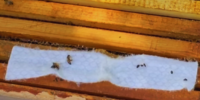
Use a scratcher or brush and scratch a little bit on the sheet to create fuzzy of cotton. The more fuzziness on the sheet, the beetles are more likely to be trapped inside it.
Place multiple similar sheets in the bottom board and in the vacant wall of your beehives. You can create some empty space above the frames and place the sheets on their as well.
Regularly inspect and remove those beetles from the sheet and reuse it for as long as it is reusable.
6) Use Oil Traps
You can also use small oil traps, which are small vacant container-like structures having a lid with open spaces for the beetles to go inside.
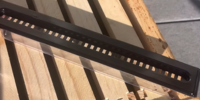
- Pour approximately ¼ inch of thickness inside the trap with oil.
- Close the lid.
- Place multiple traps at the top within the vacant spaces between frames. Make sure it fits properly and there is no chance that oils are going to spread over the frames.
Make sure to use a bee smoker to calm the bees during the process.
How to Get Rid of Beetles in a Beehive in an Emergency Situation and Prevent “Slime Out”?
It is possible that in some cases the beetles are getting out of control in number. The beehive is about or already started to slime out. In such situation, you don’t have any time to try different methods.
You need immediate action to remove the beetles and save the colony from dead out.
Here is a Step-by-Step guide on how to handle a large no. of small hive beetles and prevent the beehive from slime out. Besides these emergency steps, keep applying the methods I have discussed in the “ways to get rid of small hive beetles in a beehive” section.
Step-1: Remove The Honey Super
When the hive starts to slime out, the beetle larvae can spoil the honey. So, the first step to save the bees from slime out is to take the honey super and place it in the fridge.
Keep the super in a fridge for 72 to 96 hours you can reuse it after the beetle problem is solved.
Step-2: Save Comb & Honey
If you see frames having a lot of honey, take it out of the beehive and place it in a fridge. Similar to honey super you can reuse it after refrigerating for 3-4 days.
If your hive is already in the slime out phase, try to clear all the honey and combs at the corners of each frame.
Step-3: Tighten The Space
This is very important. As you are removing supers and frames with honey, you have to keep your bees tight. There shouldn’t be too much space left inside the hive.
As you are taking the food sources from your bees away for a few days, you can place an empty frame if needed. Bees will work to build a comb on the frame. You can also place a feeder close to the hive.
But remove all other unnecessary frames and supers that can invoke the spread of small hive beetles. Clean honey and combs regularly until the hive is successfully recovered from the beetle problem.
Step-4: Treat the Soil Under & In front of the Hive
This is also a mandatory step. Because larvae that come out from the hives will mutate in the soil under and in front of the hive. You should prevent their reproduction as early as possible.
You can use Diatomaceous earth to prevent the reproduction and expansion of the larvae and pupae. Spread Diatomaceous earth over the ground under and around your beehives.
You can try other methods, such as applying nematodes to prevent beetles from reproducing.
Hopefully, taking these actions will save your honey bee colony from slime out. Make sure to take necessary steps to prevent small hive beetles from attacking your hive again. Because prevention is better than cure.
Prevention Tips for Small Hive Beetles
Keeping hive beetles away is easier than curing a slime-out. A few smart habits can make a big difference in keeping your bees safe and your hive healthy.
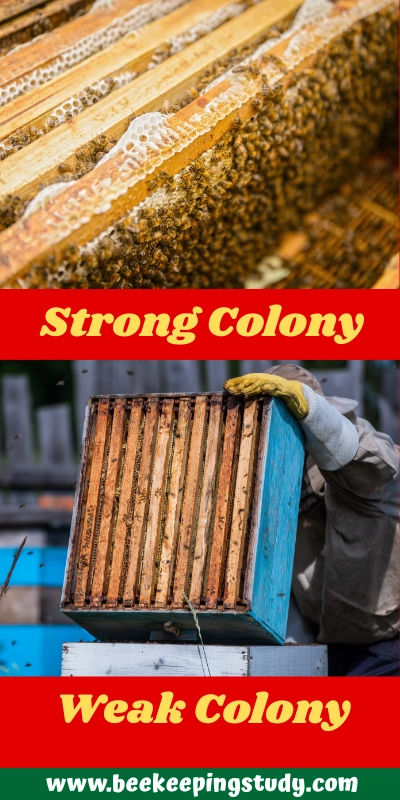
- Keep colonies strong: Healthy, crowded colonies can guard frames and chase beetles into corners. Avoid leaving weak hives unattended.
- Avoid extra space in the hive: Only keep boxes that the bees can fully cover. An empty comb gives beetles room to hide and lay eggs.
- Maintain good hive hygiene: Clean bottom boards, remove burr comb, and never leave crushed bees or honey spills near the apiary.
- Store honey supers properly: Extract honey soon after harvest. Keep stored supers in sealed bins or freezers so beetles can’t infest them.
- Control shade and moisture: Hive beetles prefer damp, shaded spots. Place hives in sunny, dry areas with good airflow.
- Use beetle traps regularly: Keep oil traps or beetle blasters inside hives during warm months. Refresh them weekly for best results.
- Treat soil under hives: Apply beneficial nematodes or a safe ground drench to stop larvae from pupating in the soil.
- Inspect often: Open hives every 7–10 days during peak beetle season. Early detection always makes control easier.
- Avoid leaving hive products outside: Wax scraps, pollen patties, or deadouts attract beetles fast. Keep the apiary clean at all times.
Placing the Beehive in the Ideal Location is Key
If you are new to beekeeping, you must choose the right spot to place your beehive. Putting the beehive in the ideal location will make your beekeeping journey a lot more easier.
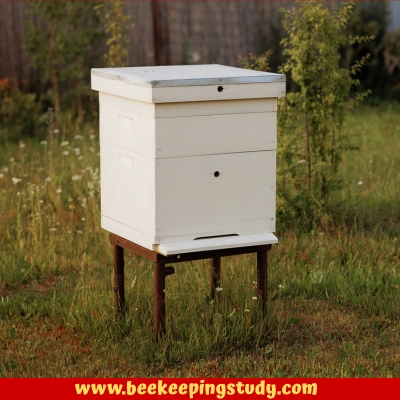
Make sure to place your beehive in a place where direct sunlight comes up for at least 4 hours a day. Because beetles don’t like warm and direct sunlight. Placing a beehive in such a location will always be helpful to keep beetles out of the beehive.
By following these small but consistent steps, you can stop hive beetles from disturbing your bees and keep your bees busy with what they do best, which is making honey.
Frequently Asked Questions
What attracts hive beetles?
Hive beetles are drawn to the smell of honey, pollen, and brood. They also like warm, humid, and shady hive areas with weak bee populations.
Will dish soap kill beetles?
Yes, dish soap can kill hive beetles when mixed with water in traps. However, never spray it directly inside the hive as it can harm bees too.
Are hive beetles harmful to humans?
No, hive beetles don’t bite or sting people. Their main threat is to bee colonies and stored honey, not humans.
How often to replace traps?
Replace or clean beetle traps every 7 to 10 days, or sooner if they fill up with oil, debris, or dead beetles.
Do sticky boards work?
Sticky boards can catch some beetles, but they are not very effective for full control. Oil traps or in-hive beetle blasters work much better.

